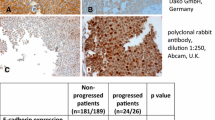Abstract
Objective
Snail, an inducer of the epithelial-to-mesenchymal transition, increases motility and invasiveness of cancer cells by repressing E-cadherin expression. We investigate the relationship between Snail expression and clinicopathological parameters and evaluate its prognostic significance in patients with non-muscle-invasive bladder cancer (NMIBC).
Materials and methods
A total of 332 patients treated with transurethral resection of the bladder tumor between October 2002 and July 2010 were histopathologically confirmed to be NMIBC. Tumor recurrence and progression were followed up in all patients. Immunohistochemical staining of 332 slices was performed. The expression of Snail was evaluated by ICH and graded for intensity and area of staining. We correlated Snail scores with clinical and pathological variables, and association of Snail staining with tumor recurrence and progression was evaluated by univariate, multivariate analysis and Kaplan–Meier survival curves.
Results
Of 332 patients with NMIBC, there was Snail positivity in 104 tumors (31.3 %), and Snail expression correlated with age, multifocality, carcinoma in situ, tumor stage and tumor grade (each p < 0.05, respectively). A multivariate Cox regression model revealed that Snail expression was an independent predictor of tumor recurrence [hazard ratio (HR) 1.95, p = 0.001] and progression (HR 2.34, p = 0.014) in patients with NMIBC. Kaplan–Meier estimates showed that Snail expression was significantly associated with recurrence and progression (log-rank test, p < 0.0001, respectively).
Conclusions
Analysis of Snail expression in 332 NMIBC tissue specimens revealed its potential usefulness as a biomarker to predict the NMIBC prognosis.


Similar content being viewed by others
References
Nieto MA (2002) The snail superfamily of zinc-finger transcription factors. Nat Rev Mol Cell Biol 3(3):155–166
Zhou BP et al (2004) Dual regulation of Snail by GSK-3beta-mediated phosphorylation in control of epithelial-mesenchymal transition. Nat Cell Biol 6(10):931–940
Xu Y et al (2010) Role of CK1 in GSK3beta-mediated phosphorylation and degradation of snail. Oncogene 29(21):3124–3133
Dominguez D et al (2003) Phosphorylation regulates the subcellular location and activity of the snail transcriptional repressor. Mol Cell Biol 23(14):5078–5089
Rosivatz E et al (2002) Differential expression of the epithelial-mesenchymal transition regulators Snail, SIP1, and twist in gastric cancer. Am J Pathol 161(5):1881–1891
Alves CC et al (2007) Slug is overexpressed in gastric carcinomas and may act synergistically with SIP1 and Snail in the down-regulation of E-cadherin. J Pathol 211(5):507–515
Blechschmidt K et al (2008) The E-cadherin repressor Snail is associated with lower overall survival of ovarian cancer patients. Br J Cancer 98(2):489–495
Jemal A et al (2011) Global cancer statistics. CA Cancer J Clin 61(2):69–90
Parkin DM (2008) The global burden of urinary bladder cancer. Scand J Urol Nephrol Suppl 218:12–20
Babjuk M et al (2012) EAU guidelines on non-muscle-invasive urothelial carcinoma of the bladder, the 2011 update. Actas Urol Esp 36(7):389–402
Kondas J (1985) Factors affecting the recurrence rate and progression of superficial (Ta-T1) bladder tumors. Orv Hetil 126(10):577–580
Allard P et al (1998) The early clinical course of primary Ta and T1 bladder cancer: a proposed prognostic index. Br J Urol 81(5):692–698
Soloway MS (2007) It is time to abandon the “superficial” in bladder cancer. Eur Urol 52(6):1564–1565
Bryan RT, Wallace DM (2002) ‘Superficial’ bladder cancer—time to uncouple pT1 tumours from pTa tumours. BJU Int 90(9):846–852
Bagnato A, Rosano L (2007) Epithelial-mesenchymal transition in ovarian cancer progression: a crucial role for the endothelin axis. Cells Tissues Organs 185(1–3):85–94
Moustakas A, Heldin CH (2007) Signaling networks guiding epithelial-mesenchymal transitions during embryogenesis and cancer progression. Cancer Sci 98(10):1512–1520
Hugo H et al (2007) Epithelial–mesenchymal and mesenchymal–epithelial transitions in carcinoma progression. J Cell Physiol 213(2):374–383
Greene FL et al (2002) AJCC cancer staging Manual, 6th edn. Springer, New York
Mostofi FK, Sobin LH, Torloni H (1973) Histological typing of urinary bladder tumours. World Health Organization: International Histological Classification of Tumors, Geneva
Rosivatz E et al (2006) Expression and nuclear localization of Snail, an E-cadherin repressor, in adenocarcinomas of the upper gastrointestinal tract. Virchows Arch 448(3):277–287
Jiao W, Miyazaki K, Kitajima Y (2002) Inverse correlation between E-cadherin and Snail expression in hepatocellular carcinoma cell lines in vitro and in vivo. Br J Cancer 86(1):98–101
Acknowledgments
This work was supported by the Health Bureau of Shanghai Municipality (XYQ2011028).
Conflict of interest
We declare that we have no financial and personal relationships with other people or organizations that can inappropriately influence our work, there is no professional or other personal interest of any nature or kind in any product, service and/or company that could be construed as influencing the position presented in, or the review of, the manuscript entitled.
Author information
Authors and Affiliations
Corresponding author
Additional information
Yuancheng Gou and Weihong Ding have contributed equally to this study.
Rights and permissions
About this article
Cite this article
Gou, Y., Ding, W., Xu, K. et al. Snail is an independent prognostic indicator for predicting recurrence and progression in non-muscle-invasive bladder cancer. Int Urol Nephrol 47, 289–293 (2015). https://doi.org/10.1007/s11255-014-0874-z
Received:
Accepted:
Published:
Issue Date:
DOI: https://doi.org/10.1007/s11255-014-0874-z




